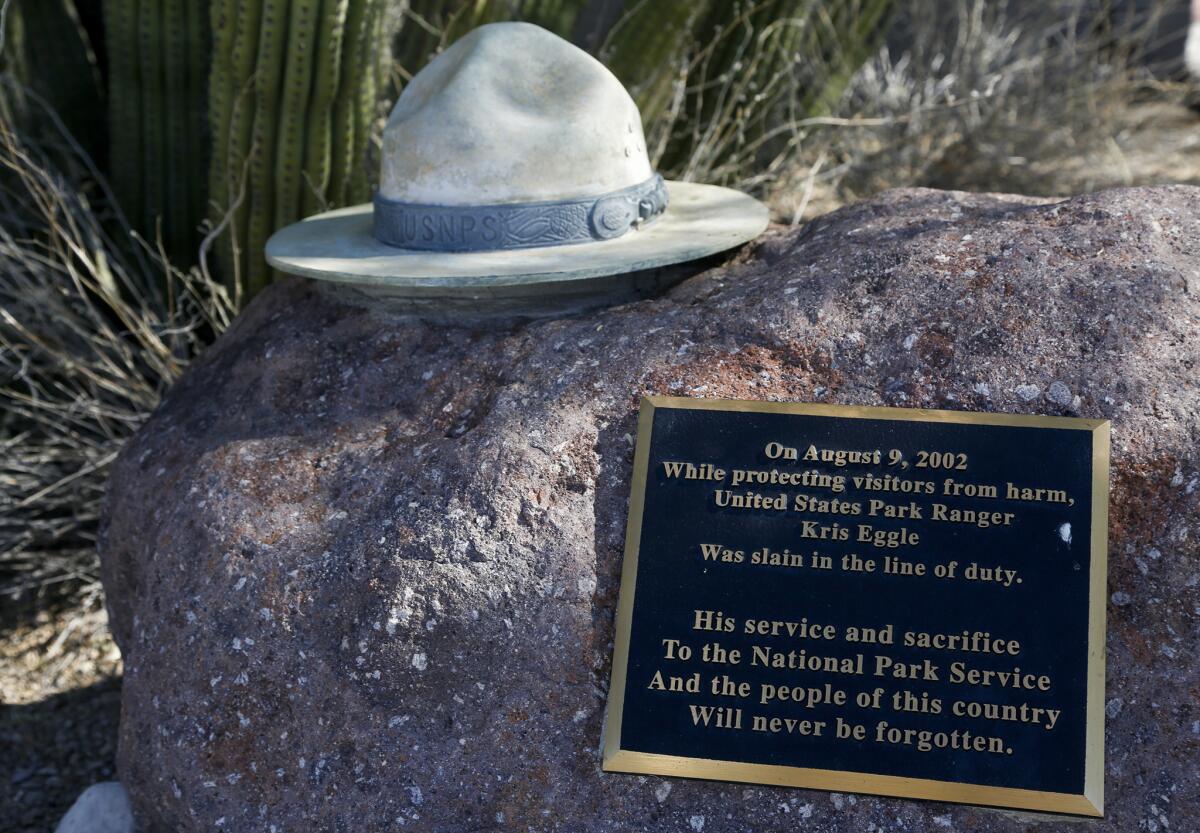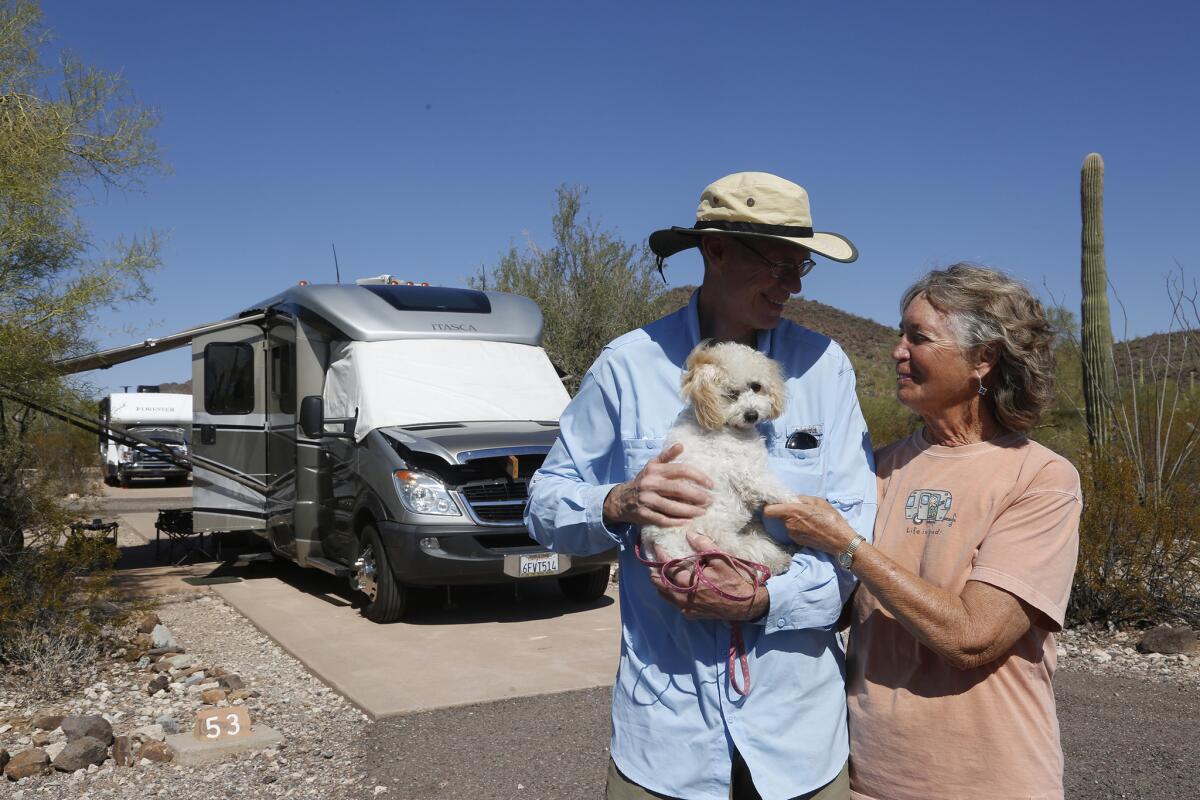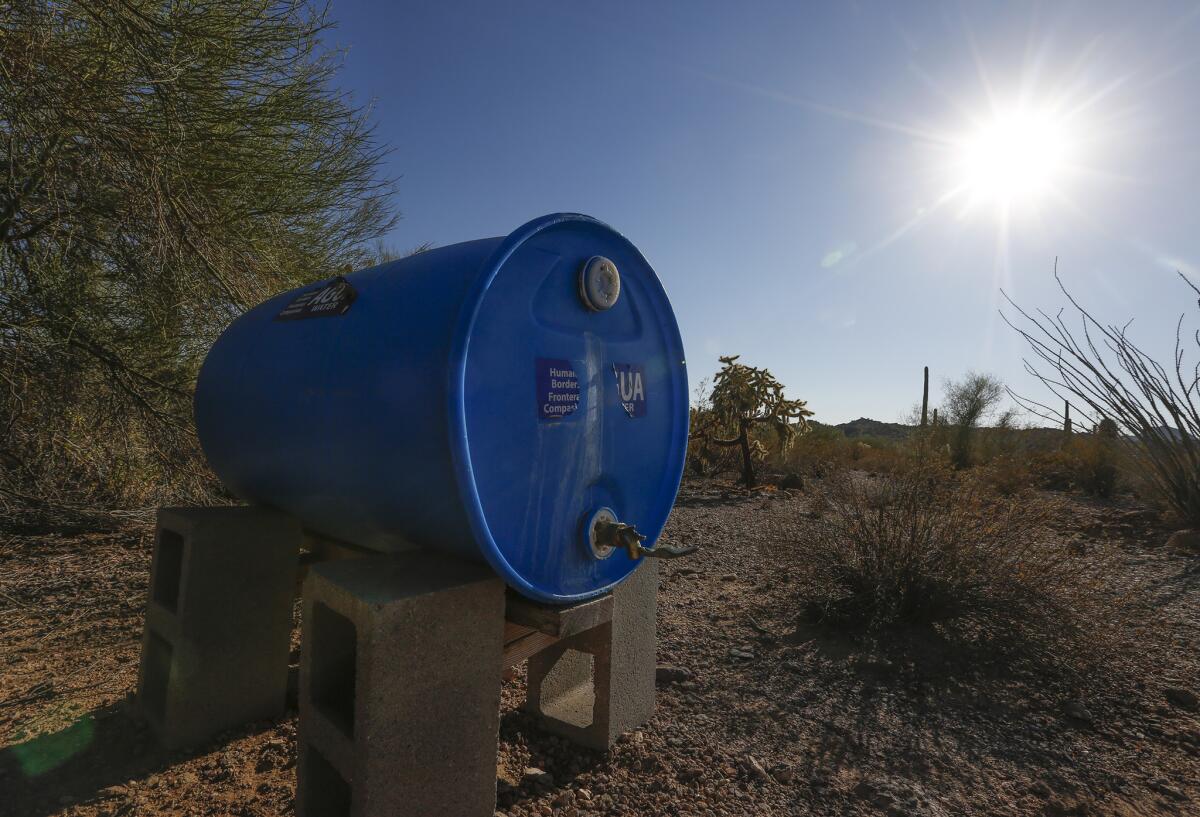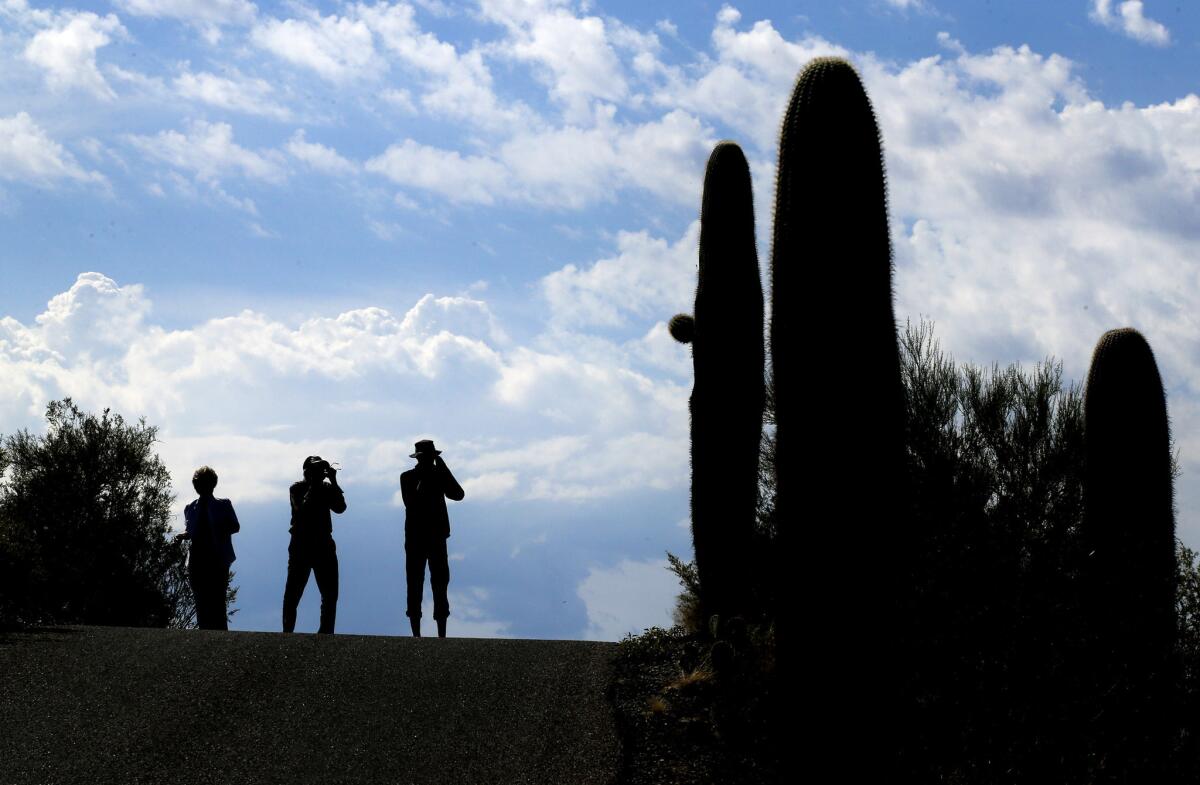With giant cactuses and sleek jaguars, Arizona’s Sonoran Desert has an edgy beauty tinged with danger

It was 10 a.m. and already 100 degrees.
I could feel the moisture being sucked from my body as I climbed toward a cluster of pale green cactuses. Their serpentine arms waved gently like desert anemones in the scorching wind.
I was hiking through Organ Pipe Cactus National Monument, a wild sliver of the Sonoran Desert whose botanical wonders include its namesake cactus, seen almost nowhere else in the United States.
From the hilltop, hundreds of organ pipes, some 25 feet tall, crowded the sandy floor. A few perched atop the upper slopes of rugged Mt. Ajo across the valley.
The silence was absolute. I wished for the manic chattering of a cactus wren to break its grip. It was mid-October. Back home in Colorado the air was crisp and the aspens golden. Here all was rust-colored rock and unrelenting heat.
And that was the point.
Series: Celebrating our national parks »
I came to experience the heart of the Sonoran Desert, said to be the most biodiverse desert in the world. A vast array of plants, reptiles, birds and mammals, including America’s only jaguar population, inhabit this harsh world.
Summer monsoons and winter rains combine with sun and heat to create spectacular life forms such as organ pipes and saguaros.
There are the octopus-like senitas and hulking barrel cactuses along with rare elephant trees. Lithe paloverdes and shapely mesquites fill in the blanks.
Perhaps the best place to explore the Sonoran is here in Organ Pipe and farther north in Saguaro National Park.
They are part of the same desert yet very different. Saguaro is divided by a major metropolitan area, east and west sides separated by 30 miles of Tucson.
Organ Pipe, an International Biosphere Reserve, is far more remote. It shares 31 miles of border with Mexico. The nearest decent-sized American town is Ajo, which has a handful of restaurants and motels.
I left the swaying organ pipes and made for the Kris Eggle Visitor Center, named for a park ranger whose life colors the recent history of this place.
In 2002 a pair of drug smugglers fleeing Mexican authorities entered the park and were chased by Eggle and Border Patrol agents. One of the suspects opened fire with an AK-47, killing Eggle. The perpetrator escaped into Mexico where he was killed by police.

Beauty and risk
That is the paradox of Organ Pipe.
The very location that makes this 517-square-mile monument starkly beautiful has, in the past, made it dangerous.
It sits astride prime human- and drug-trafficking routes. For 11 years until 2014, nearly 70% of Organ Pipe was closed to visitors because of illegal activity. The media called it “the most dangerous national park in America.”
Susan Walter, the monument’s chief of interpretation, said Organ Pipe is a different, more secure place these days.
“For one thing, 100% of it is open to the public, thanks to cooperation with the Border Patrol,” she said.
“They put in a vehicle barrier to stop people from driving through illegally from Mexico, and there are surveillance towers. We believe we have taken the necessary prudent steps to keep visitors as safe as we can.”
Visitation, which had dropped to 21,582 in 2011, was 35,082 in (fiscal year) 2016.
I headed to the Twin Peaks campground past a sign warning that “smuggling and illegal immigration may be encountered in this area.” Visitors are asked to dial 911 if they see anything suspicious.

I found Frank Yancey and Barbara Deese from San Diego relaxing under the awning of their RV.
Yancey was cradling his poodle, Sophie. He told me they had been coming to Organ Pipe for more than a dozen years.
“This park is gorgeous and has some of the best facilities around,” said Yancey, a retired school teacher. “When we first came a lot of the roads were closed, but we have never had any problems.”
The campground host was John Zaleski, an accountant from New Jersey. After the death of his mother, he decided a major change was in order.
Tips for visiting Organ Pipe Cactus National Monument »
He sold his condo, bought a mobile home and found a job in this lonesome desert.
“To be honest, I was a little concerned at first but now feel more at ease,” he said. “I feel completely safe here.”
One of the most popular ways to see Organ Pipe is along Ajo Mountain Drive, a 21-mile, graded dirt road loop with lots of turnoffs that let you explore the desert on foot.
A pamphlet lists 18 stops along the route. Stop 4 puts you beside a collection of large organ pipe cactuses.
The extreme heat and lack of frost make this an ideal home for them. Unlike the saguaro, they don’t need to spend their early years in the shadow of another plant. They thrive in the blazing sun.

Humanitarian groups have placed blue tanks of water to aid immigrants crossing the desert in Organ Pipe National Monument.

U.S. Customs and Border Protection vehicles man the metal border fence with trucks, cameras and regular patrols in the park.
In May and June their sweet-smelling blossoms are pollinated by nectar-feeding bats. If you cross the border, you can follow the organ pipes down to the turquoise seas of Baja California.
As I walked through the desert, I saw a flag waving just ahead. A big, blue barrel of water stood under it, set out by a humanitarian group aiding undocumented immigrants.
Farther along, the vehicle barrier along the Mexican border was clearly visible, a Border Patrol truck parked alongside it. More than 500 border agents patrol the area.
I stopped at a convenience store in tiny Lukeville, the last town on the U.S. side of the border. A pickup truck outside was stacked with washing machines, perhaps to sell in Mexico.
Border Patrol officers had a young man in handcuffs. He looked hot and weary. We exchanged glances and I headed north.

Forest of saguaros
Along the way, I passed through the sprawling Tohono O’odham Reservation and stopped in the hamlet of Why to admire an outdoor bathroom covered in splendid murals of horses, desert scenes and one tall glass of water.
I entered the east side of Saguaro National Park and was greeted by perhaps the most iconic cactuses in the world.
Some of the saguaros were more than 50 feet tall and 2 centuries old. Industrious woodpeckers had drilled holes in their arms. Bird nests sat among the spines.
Saguaros are whimsical things with chaotic, twisting limbs. One resembled a runner, another a gunfighter and a kindly looking specimen appeared to reach for my hand.
The woody skeletons of their dead compadres lay scattered about, fragments of desiccated skin resembling alligator hide.
I asked park spokesperson Andy Fisher why saguaros are limited to the Sonoran.
“We are barely a desert because we get so much precipitation,” she said. “That’s why we have so many saguaros.
“Saguaros need winter and summer rain, and that’s what we get.”
They bloom at night during the heat of summer. The Tohono O’odham people harvest their fruit for jams, syrup and ceremonial wine.
I joined ranger Cam Juarez for a walk among the saguaros. Juarez is the son of Mexican migrant farmworkers. A birth defect significantly shortened both arms, which he believes was caused by a pesticide used in the fields where his mother worked while pregnant.
He is passionate about the park and working to promote it among the city’s diverse population.
“The majority of visitors are from out of town,” he said. “Germany is the No. 1 contributor, followed by Japan and China.
“Tucson is 62% Latino yet many don’t even know we are here.”
Saguaro’s 91,000 acres extend from the gnarly tree chollas of the desert floor to the pines of the Rincon Mountains.
As Juarez and I walked, families of quail dashed past. Mourning doves cooed from saguaro tops. A brazen hummingbird dropped from the sky to inspect us before buzzing off.
Tips for visiting Saguaro National Park »
Juarez told me the east side has more wilderness, but the west has three times as many saguaros. That’s because of years of cattle grazing in the east, disease and a rare freeze in 1937 that killed thousands of saguaros, he said.
On the west side, I was greeted by thousands of saguaros standing behind the visitor’s center.
I headed for the Signal Hill trail head. The path wound up toward a pile of basalt rocks inscribed with animal and spiral petroglyphs by the prehistoric Hohokam people.
I looked over the valley and watched the sun slowly sink into the desert. A warm breeze carried the jumbled scents of creosote and sage.
Down below, the saguaros glowed yellow and then orange. Soon they were crooked silhouettes against a starry sky.
Sign up for The Wild
We’ll help you find the best places to hike, bike and run, as well as the perfect silent spots for meditation and yoga.
You may occasionally receive promotional content from the Los Angeles Times.



